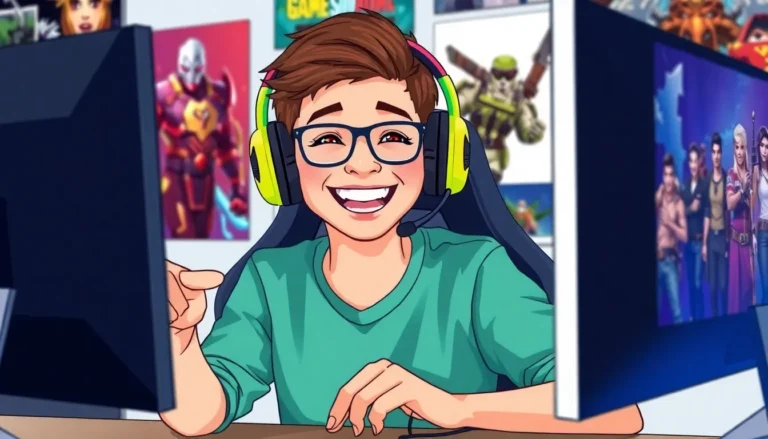In the world of gaming, cutscenes can be a double-edged sword. On one hand, they deliver gripping narratives and stunning visuals that pull players deeper into the story. On the other hand, they can feel like an eternity when all someone wants to do is jump back into the action. Enter the cutscene skip option—a hero in disguise that saves players from the clutches of boredom and lets them reclaim their precious gaming time.
Imagine this: you’re on the brink of an epic battle, but first, you must endure a ten-minute monologue about the history of a fictional kingdom. With the cutscene skip option, players can say goodbye to tedious interruptions and hello to uninterrupted gameplay. It’s not just a feature; it’s a game-changer that respects players’ time and keeps the adrenaline pumping. So, let’s dive into why this option is more than just a button—it’s a lifeline for gamers everywhere.
Table of Contents
ToggleOverview of Cutscene Skip Options
Cutscene skip options provide players with increased control over their gaming experiences. These options allow for the swift passage through or the complete avoidance of lengthy cinematic sequences. Respecting players’ time becomes a priority as developers integrate these features into games.
Not every game features a cutscene skip option, but many modern titles recognize its importance. Players often express a desire for participation and engagement, and a skip option supports that need. Games like “The Last of Us Part II” and “Final Fantasy VII Remake” include this feature, showcasing its growing significance in the industry.
Players benefit from the ability to choose how they experience the narrative. This flexibility enhances enjoyment and caters to varying play styles. Some players appreciate fully immersing themselves in stories, while others prefer to retain momentum in fast-paced action.
Game developers frequently adjust the length and frequency of cutscenes based on player feedback. The inclusion of skip options reflects a commitment to improved gameplay. Companies like Naughty Dog and Square Enix have shown leadership in adopting these practices, promoting player-centered design.
In multiplayer environments, cutscene skip options play a critical role. They ensure that teams can regroup and refocus quickly, minimizing downtime. Gamers benefit from seamless transitions, allowing for strategic planning without interruptions.
Furthermore, accessibility for all players has gained importance in the gaming community. Including a cutscene skip option supports inclusivity, making games more enjoyable for individuals with varying preferences and needs.
Benefits of Cutscene Skip Option

Cutscene skip options significantly enhance gameplay by providing players with better control over their experiences. These features encourage a more personalized journey through gaming.
Enhancing Player Experience
Players feel empowered when they can decide whether to engage with cutscenes. Allowing for the choice of skipping promotes a sense of autonomy. Many appreciate this flexibility, particularly in narrative-heavy games. Some players thrive on cinematic storytelling, while others prioritize fast-paced action. With this option, developers cater to diverse preferences. The skip feature fosters a more inclusive environment, appealing to casual gamers and completionists alike. Ultimately, it enhances immersion, as players can choose their pacing and emotional engagement.
Improving Game Pace
Cutscene skip options improve overall game pace, preventing unnecessary interruptions. Players seeking seamless gameplay quickly bypass lengthy scenes. As a result, momentum is maintained, making sessions more engaging. Developers recognize that downtime in multiplayer games can disrupt teamwork. By implementing skip options, they minimize waiting periods, allowing for swift transitions between action and storytelling. Feedback from players influences the design of these features, ensuring they align with community preferences. This responsiveness enhances the gaming experience by keeping players engaged and focused on the objectives at hand.
Popular Games Featuring Cutscene Skip Option
Many popular games recognize the importance of cutscene skip options.
“The Last of Us Part II” allows players to bypass cutscenes, promoting continuous gameplay. This feature provides flexibility, catering to different player preferences and play styles.
“Final Fantasy VII Remake” also offers this option, enabling players to skip cinematic sequences and maintain momentum. Engaging with this feature enhances the experience for those who prefer a fast-paced adventure.
“God of War” includes a cutscene skip option, giving players control over their gaming journey. Players can choose to either dive into the story or move quickly through the action, aligning with their individual gaming style.
“Resident Evil 2” emphasizes this feature as well. Players can skip cutscenes during replay, making it easier to tackle challenges without repeated interruptions. This flexibility supports players seeking to improve their skills without the distraction of lengthy narratives.
“Minecraft Story Mode” utilizes cutscene skips, allowing users to experience the story at their own pace. This enhances enjoyment for those who want a more streamlined approach without sacrificing narrative engagement.
“Dark Souls III” acknowledges the preference for fast-paced action by including a cutscene skip option. Quick access to gameplay keeps the adrenaline high, allowing players to focus on strategies and challenges.
Many developers are responsive to community feedback on cutscene features. The emphasis on player autonomy reflects a commitment to create engaging and enjoyable experiences across various genres.
Player Feedback on Cutscene Skip Option
Players generally appreciate cutscene skip options for their ability to enhance gaming experiences. These features promote player autonomy, allowing individuals to dictate their own pace. Many gamers express that skipping cutscenes helps maintain immersion and excitement during gameplay.
Positive Reactions
Feedback often highlights a strong favor for the flexibility offered by cutscene skip options. Gamers value the ability to bypass lengthy sequences in titles like “God of War” and “Resident Evil 2.” Countless players feel that these included features respect their time and cater to diverse gaming styles. Gamers who prefer fast-paced action find these options particularly beneficial. Enhanced customization fosters enjoyment and engagement within communities. Developers notice the positive impact on overall game enjoyment, resulting in increased player satisfaction.
Critiques and Concerns
Not all feedback is positive regarding cutscene skip options. Some gamers express concerns that fast-forwarding through cutscenes detracts from story engagement. Players worried about missing vital plot points highlight the balance between gameplay and narrative. Additionally, a few argue that constant skipping can reduce the emotional impact designed by developers. Developers must consider this while optimizing cutscene lengths and frequencies based on player feedback. Striking a balance ensures that gameplay remains enjoyable while preserving significant storytelling elements.
The cutscene skip option represents a pivotal advancement in gaming design. By offering players the choice to bypass cinematic sequences, developers enhance gameplay fluidity and respect individual preferences. This feature not only caters to diverse play styles but also fosters a more engaging experience, particularly in fast-paced or multiplayer settings.
As the gaming landscape evolves, the emphasis on player feedback continues to shape how cutscenes are integrated. Balancing narrative depth with gameplay pace remains crucial. Ultimately, the inclusion of cutscene skip options reflects a commitment to creating immersive and enjoyable experiences for all gamers.





